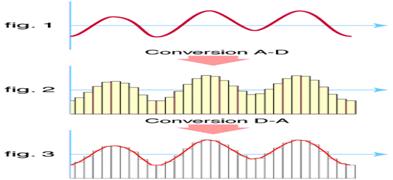Theoretical Paper
- Computer Organization
- Data Structure
- Digital Electronics
- Object Oriented Programming
- Discrete Mathematics
- Graph Theory
- Operating Systems
- Software Engineering
- Computer Graphics
- Database Management System
- Operation Research
- Computer Networking
- Image Processing
- Internet Technologies
- Micro Processor
- E-Commerce & ERP
Practical Paper
Industrial Training
Encoding D/A and A/D Encoding

The modulation methods that we have examined so far, such as AM and FM, are considered as being 'analogue to analogue', with a typical application being radio transmission.
The types of digital to analogue modulations are referred to as shift keying. The four main types are:
- Amplitude Shift Keying (ASK)
- Frequency Shift Keying (FSK)
- Phase Shift Keying (PSK)
- Quadrature Amplitude Modulation (QAM)

With FSK it is only the frequency that is changed, amplitude and phase remain the same.
FSK can help avoid the noise problems beset by ASK because the receiver is tuned to certain frequencies, however, FSK requires two carrier signals, ie: a higher frequency for binary 1s and a lower frequency for binary 0s
FSK is used for modems up to a maximum speed of 1200 bps.
FSK also makes use of guard bands to avoid signal overlap.
FSK and ASK are regarded as being slow and it is only by combining different shift keying techniques that higher data rates can be achieved through normal telephone lines.
Click on this link to review the wikipedia resource on frequency shift keying.
| Bit | Phase |
|---|---|
| 0 | 0 |
| 1 | 180 |
PSK works by causing a change known as a wave shift in a signal. This can be achieved by delaying a signal without changing its amplitude or frequency. This modified signal can then be assigned a value, ie: binary 1, whereas the unchanged carrier signal will be binary 0. This is know as Binary Phase Coherent PSK, ie: one phase is 0o and the other 180o
Click here to review the wikipedia resource on phase shift keying.

This is the digital to analogue version of Amplitude Modulation. Similarly to AM it is the signal strength that dictates the binary value and only the amplitude changes while the frequency and phase stay the same.
A drawback of ASK is that it is susceptible to noise interference and entire transmissions could be lost due to this.
When using ASK there is a one to one relationship between bit rate and baud rate.
One use of ASK is with fibre-optic data transmission. With a high light intensity representing a binary 1 and a low intensity representing a binary 0.
Click on this link to look at the wikipedia resource on amplitude shift keying.

